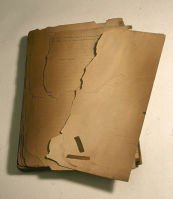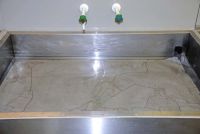The conservation team at Surrey History Centre faces a daily challenge in rescuing the many records that arrive in varying degrees of disrepair and fragility. What is often not realised, however, is that many paper documents carry within them the seeds of their own destruction because of developments in paper manufacture. Before the 19th century, most paper was made of pulped linen rags and, stored correctly, is very durable. The introduction of mass-produced paper, using wood pulp containing high levels of acidity, meant books, documents and newspapers could be produced more cheaply but rendered them liable to rapid deterioration, including brittleness and discolouration.
 The main enemy is lignin, a highly complex organic acid, present in mechanical wood pulp papers. It is vulnerable to oxidation and light and its by-products will attack the paper's cellulose. However other factors, too, can affect the levels of acidity in paper products. These include:
The main enemy is lignin, a highly complex organic acid, present in mechanical wood pulp papers. It is vulnerable to oxidation and light and its by-products will attack the paper's cellulose. However other factors, too, can affect the levels of acidity in paper products. These include:
- Absorption of sulphur dioxide from the air and its reaction with the metals present in the paper.
- Iron copper and aluminium sulphate used in the gelatine and rosin sizing of paper will lead to the formation of sulphuric acid.
- Iron-gall inks give rise to acidity due to the interaction of the ferrous sulphate with tannic and gallic acids.
- Acid migration may occur when paper is in direct contact with chemically unstable substances found in adhesives, board, and wrapping paper.
- Foxing and mould growth can produce acids from their metabolic process.
 A key treatment is the addition of alkaline compounds to acidic paper in a process called deacidification (or neutralisation) which can help to extend the document's life expectancy. A deacidification process should effectively remove or neutralise acids in paper and also deposit an alkaline reserve or buffer.
A key treatment is the addition of alkaline compounds to acidic paper in a process called deacidification (or neutralisation) which can help to extend the document's life expectancy. A deacidification process should effectively remove or neutralise acids in paper and also deposit an alkaline reserve or buffer.
The amount of acidity present in paper can be determined by calculating the hydrogen ion concentration. The pH (potential hydrogen) can be measured from the surface of paper or from its aqueous extract prepared by macerating a tiny quantity with fresh distilled or deionised water.
Before immersing paper in a deacidification bath, inks, illumination and decoration have to be checked to ensure they will not dissolve in the solution. The three alkaline solutions generally used in the process are Calcium Hydroxide or Ca(OH)2, Magnesium Bicarbonate or Mg(HCO3)2, which helps prevent the discolouration of wood pulp paper, and Barium Hydroxide or Ba(OH)2. In each case the alkali neutralises the sulphuric acid in the paper and creates a buffer for long-term preservation.

